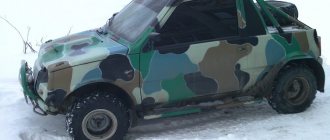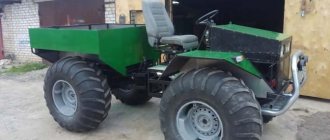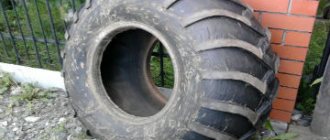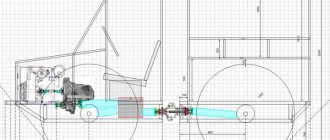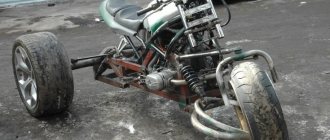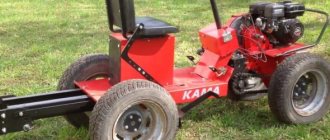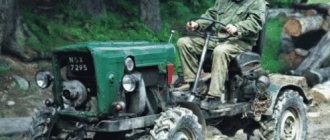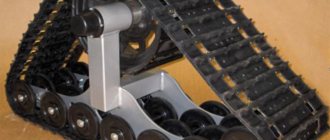all the best! Not long ago I converted the Oka into a jeep, but only now, with the arrival of spring, the Oka was finally able to take mud baths (including us). The ride was light, or rather even the first ride into the mud after assembly. checked for strength and cross-country ability, in general, nothing came loose or fell off. I was pleasantly surprised by the cross-country ability, it really can) on the car: - body lift, 13 cm spacers - quad tires with splices - differential welding p/s we are planning more combat trips in the near future , everything will be documented)
All-terrain vehicle fracture 4x4 "Bukinda"
This
all-terrain vehicle
was created for hunting and fishing, therefore, it has an insulated kung for overnight stays in the winter. The car has positive buoyancy. but poor control on the water. On land, the all-terrain vehicle has excellent maneuverability.
To create this all-terrain vehicle, the following parts and materials were needed: 1) Internal combustion engine from a VAZ 1111 2) Axles from a Niva car 3) axle cam from an UAZ 4) a manual gearbox from a Niva 5) profile pipe measuring 50 by 20 and 40 by 20 6) steering taken from UAZ 31512 without hydraulics. 7) Homemade wheels from A. Vologda Wheels Trekol 1300 to 600 9) Windshield on special. to order 10) A windshield wiper from an Oka car 11) The pedal assembly was also taken from an Oka 12) disc brakes and calipers from an Oka 13) Hella headlights 14) AMG 2 mm was used as the casing 15) an exhaust pipe from an Oka 16) a Toyota carina radiator 17) cap from a 5 liter bottle as a radiator cap. 18) winch Warn rt40
Let's take a closer look at the creation of the main components of the all-terrain vehicle.
The frame was created independently entirely from a profile pipe. The bipod from the “loaf” was shortened.
Then the author began installing axles and main components on the all-terrain vehicle:
The weight of the all-terrain vehicle is 800 kilograms with oil and antifreeze. The front bogie of the all-terrain vehicle weighs 480 kilograms, and the rear bogie weighs 300 kilograms. Thus, the ratio of the mass of the all-terrain vehicle to the load-carrying capacity of the wheels is quite good and the all-terrain vehicle will have positive buoyancy. That is, even the front bogie will not fall below the middle of the wheel.
A steering column from a Niva car was installed, as well as 1300 wheels and an Oka engine. The engine thrust with such a design is enough to pass through swamps and bogs at minimum speeds. The total gear ratio is 130, the author plans to increase it to 160.
Also interesting: Tracked twin-engine all-terrain vehicle “Serenky”
Then the author began to create a frame for the kung car:
The next step was for the author to cover the car:
In the fall, a hiking route with a total length of 140 kilometers was undertaken in a group of all-terrain vehicles. During the journey, 40 liters of fuel were consumed, with an all-terrain vehicle load of 200 kilograms of cargo and two passengers. The working pressure of the chambers on simple sections of the route was set to 0.12, and on difficult sections to 0.05.
The winch was used twice during the journey.
The breakdowns included the following: a bolt on a part of the gear shift shaft came loose, the part came off but was put back in place under field conditions. The relay-generator also failed, so I had to connect the wires from the brush to a straight line.
After the trip, the author made the following conclusions regarding the design of the all-terrain vehicle. The all-terrain vehicle has decent cross-country ability even on soft and grassy soils. The all-terrain vehicle floats very slowly and, due to its size, is highly exposed to the wind, that is, it floats in the direction of the wind, but goes ashore very easily. It goes very slowly through heavy mud, but it still goes, lowering the tire pressure especially helps, but still the maneuverability in such conditions is far from perfect. Without hydraulic power steering, maneuvers are quite tiring.
Due to the large kung, visibility when reversing is completely absent. And so it turned out to be quite a good unit for two people for hunting and fishing.
Photos of the all-terrain vehicle cabin:
Gearboxes were installed in axles starting from a penny and the gear ratio was reduced. It remains to install the GP from the 650 cc Oka. In the future, it is planned to lighten the front bogie and the all-terrain vehicle as a whole.
And here is a more detailed image of the location of the structural fracture:
With the onset of winter, the author began testing tires on winter snow. The Trekol “checker” tires performed best in the snow when they were worn out before the formation of a fold; there are no problems with it even when climbing; the “tree” based on Trekol tires begins to slip a lot even on a flat surface. The tires 1300 by 530 by 533 only follow the tracks of another all-terrain vehicle, but in deep snow the all-terrain vehicle simply buries itself along the frame on this type of tire.
Photos of the finished all-terrain vehicle:
The author of the all-terrain vehicle: Vladimir with the nickname “Bolodia” from Khanty-Mansi Autonomous Okrug-Yugra.
Lada Oka All-wheel drive Syncro › Logbook › all-wheel drive gearbox is ready
Let me remind you: the most important task was to make the same shank for transmitting torque to the bevel gear, this operation is not simple, and most importantly there were very serious concerns that this unit would not fall apart on the first exit, in the end the decision was made to implant gearbox VAZ differential housing from the Passat. they look almost alike
It would probably have been easier to just attach the entire VW box at once, but it is very heavy, and most importantly, I need a lowering pair because the car is built for driving on dirt roads, light off-road and for household needs (pulling a trailer) in fact, here is the “tuning main pair” with a ratio of 5.3 instead of the standard 4.1
The differential housing was modified many times on a lathe in order to fit into the gearbox housing. It was necessary to modify both the housing itself and the bearing mounting locations
The bearings themselves from the VW differential are installed through adapter rings
As I already said, the differential housing was machined several times in order to go as deep as possible to the bottom without touching the crankcase walls. The final operation was to measure the gap between the crankcases and groove the bearing so that no distance shims were required
I also had to modify the planetary gear because it should be attached to the VW differential housing on one side and on the VAZ on the other
I also had to prepare a diff housing for mounting on the other side for the planetary gear
According to the law of meanness, the holes for attaching the gear to the body were a multiple of the number of bolts but with different diameters. Having drilled the necessary holes, the problem arose that the edges of the bolt heads rested against the body, I spent a long time looking for bolts! I found only one version of bolts with an internal hexagon with a hardening number of 12, but a package of 100 pieces for 50 rubles each... in the end I had to be content with bolts from the ball basins of the new model, which everyone criticizes so much for the fact that they are for Torex. By the way, I also had to look for bolts because They don’t come with a ball joint and aren’t available in stores. They have a hardening level of 10, but I hope that they’re enough for a stock motor. Anyway, I had to slightly mill the body for the bolt heads.
on the reverse side the bolts had to be trimmed with a grinder
of course I changed the bearings and seals in the box and put everything back together
Source
Spare parts and materials
The design of a “breakable” all-terrain vehicle based on the Oka engine, pedals, and brakes also includes:
fist from the bridge of the Ulyanovsk car;
tubular profile 50x20, 40x20;
steering wheels from UAZ (they don’t use hydraulics);
custom-ordered windshield;
radiators from Toyota;
Also interesting: ❶ How to increase the cross-country ability of the Niva



